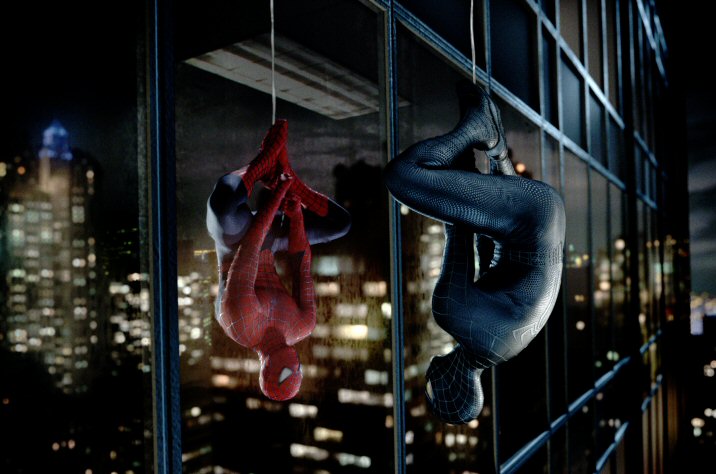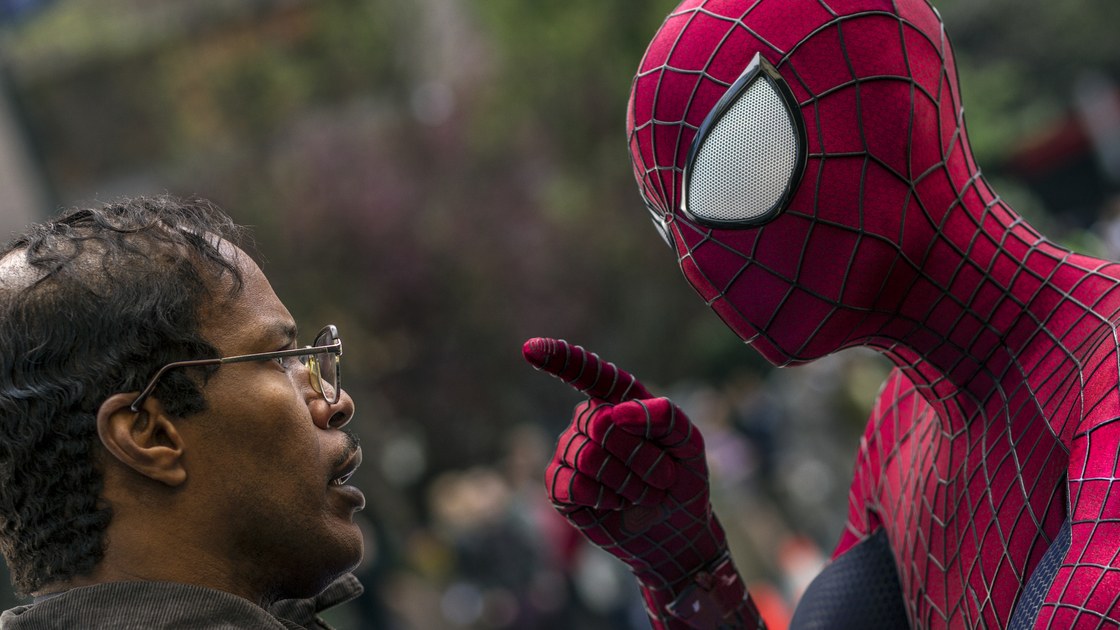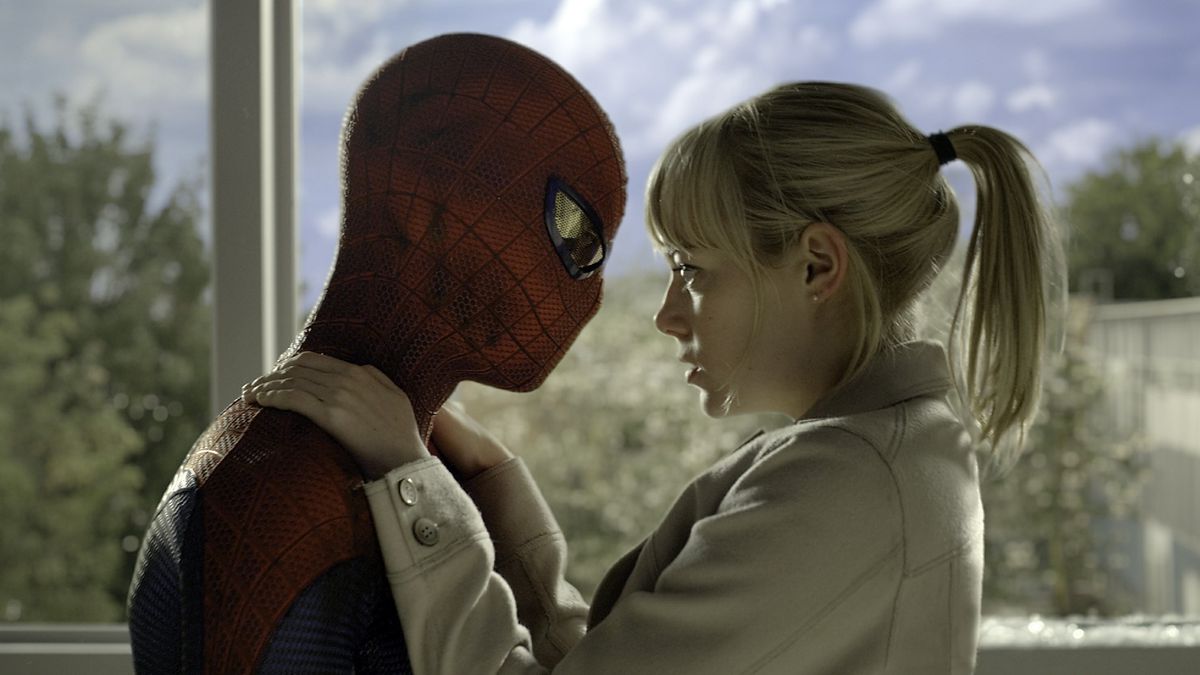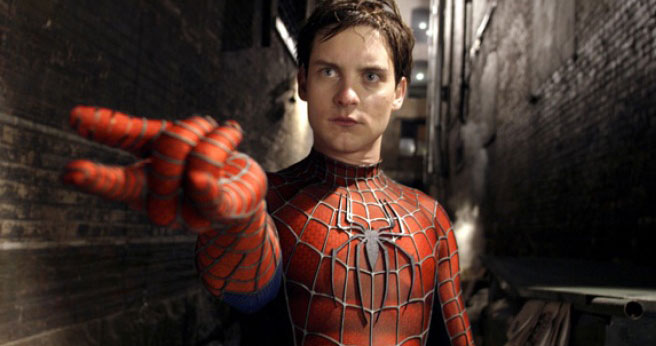
Another year, another Spider-Man. The past 15 years have given us three different visions of the web-slinging hero and 6 movies of varying quality. While some have captured the spirit of what makes a great superhero movie, others have fallen remarkably flat.
6. Spider-Man 3

No one has ever walked out of a superhero movie and said “It was good, but you know what it really needed to be great? A jazz dance scene.” Unfortunately, no one told Sam Raimi, who decided that a cheesy, baffling dance scene was exactly what his third Spider-Man installment needed. Spider-Man 3 is a long, overstuffed film that abandoned any attempt to craft a well-rounded villain in favor of giving the audience a host of bad guys and subplots that are half-baked and difficult to follow.
NPR film critic Bob Mondello fitfully dubbed Spider-Man 3 “As The Web Turns,” in reference to how the movie felt more like a soap opera than a superhero flick. Having already happily paired up Peter Parker (Tobey Maguire) and Mary Jane (Kirsten Dunst) in Spider-Man 2, Raimi felt the need to throw a wrench in their relationship and spends way too much screen time trying to patch it together again, time that should have been spent giving depth to his villains. Spider-Man 3 is a perfect example of what happens where too many ideas are forced into one film, the result is confusing, underdeveloped, and unfocused.
5. The Amazing Spider-Man 2

Like Spider-Man 3, The Amazing Spider-Man 2 suffers from trying to cram too much plot into one film. We’ve got the main villain, Electro (Jamie Foxx), a dying Harry Osborn (Dean DeHaan) on his way to becoming the Green Goblin, Peter Parker (Andrew Garfield) trying once again to salvage his relationship with his love interest, a tragic death, the introduction of yet another villain (Paul Giamatti)…the list goes on.
Jamie Foxx is a solid performer and Paul Giamatti is one of the greatest actors of our time, and while they are both giving it their all here, the film gets too wrapped up in trying to introduce all its other subplots to give either actor their proper due.
A good superhero movie shouldn’t have to rely on more than one villain to keep the audience interested. One thought-out villain with a clear motive and strong backstory should be more than enough. If a director feels as though their primary villain isn’t enough to carry the main conflict in the film, the answer shouldn’t be to add more bad guys, it should be to go back to the script and look for ways to strengthen that original character. The Amazing Spider-Man 2 and Spider-Man 3 both went for quantity over quality and created bloated endings to their directors’ takes on the franchise.
4. The Amazing Spider-Man

10 years after Tobey Maguire swung into theaters as the first live-action Spider-Man in decades, Sony decided to try their hand at the franchise with 2012’s The Amazing Spider-Man. The film was received fairly well due, in part, to its strong casting of Andrew Garfield as the lead and Emma Stone as his love interest, Gwen Stacey. Both actors were beginning their meteoric rise and their strong on-screen chemistry was clear through their well-written banter.
Garfield had a swagger and angst to him that seemed to breathe new life into the character, despite the fact that the basic plot – Peter Parker gets bit by a spider, becomes Spider-Man, Uncle Ben dies, villains appear, Spider-Man fights them – remained largely the same as the films before it. Stone’s Gwen Stacey was also a sharper, more rounded character than Kirsten Dunst’s Mary Jane, who spent the first movie as little more than a lusted- after love interest.
The Amazing Spider-Man also kept its script tight, focusing on only one villain (Rhys Ifans) to leave room for Peter’s backstory to develop, which included a mysterious take on the history of his parents, which the Sam Raimi Spider-Man films never addressed. People had their doubts about this film, which many considered to be a woefully premature remake, but it was able to hold up its own by adding enough unique touches and making Peter Parker just a bit more badass.
3. Spider-Man

While both Spider-Man and The Amazing Spider-Man do a decent job showing us Spidey’s backstory, Spider-Man earns its higher rating on this list by overcoming decades worth of obstacles and blazing the way for many superhero movies to come. 2002’s Spider-Man was the first film to surpass $100 million on its opening weekend, and it managed to do so despite being passed through the hands of countless screenwriters and directors over the years.
Spider-Man was the first modern superhero summer blockbuster film, a genre which now includes the likes of Iron Man, The Avengers, Wonder Woman, Guardians of the Galaxy, and many other beloved movies. Along with all this, it was an entertaining, well-written, well-cast film, that focused on developing the personality of Peter Parker and his complicated relationship to one of his most infamous villains, the Green Goblin (Willem Dafoe), without trying to overload the audience with too many characters.
Tobey Maguire does an excellent job of making us root for his traditionally nerdy Peter Parker and deftly portrays not only the adolescent excitement of obtaining superpowers but also the guilt of inadvertently causing Uncle Ben’s death, one of the most important hallmarks of the character. It was a great reintroduction to a character who had not seen a live-action portrayal since the 70’s, and an important introduction to audiences of a new breed of superhero films.
2. Spider-Man: Homecoming

The latest incarnation of Spider-Man has a lot going for it – a highly likable Peter Parker (Tom Holland), a strong villain played by an Academy Award nominated actor (Michael Keaton), and the support of an already-established widely popular franchise. Spider-Man: Homecoming sets itself apart from other Spider-Man movies from the very beginning by skipping over the parts of the backstory that everyone already knows and no one needs to see again – the lab visit, the spider bite, Uncle Ben’s death – all of these things have already occurred before the story starts.
It also differentiates itself by being thoroughly 2017, Peter’s bully isn’t a burly jock but rather a rich DJ (Tony Revolori), who uses snarky words instead of his fists to humiliate our hero. It also gives us a modern take on Aunt May (Marisa Tomei), who for the first time does not come off as a purely tragic, put-upon character but a young, witty caregiver.
Most importantly, Spider-Man: Homecoming never lets you forget that Peter Parker is still a teenager who has a lot of growing up to do. This not only makes it more enjoyable to watch as he gets stronger and gains more control over his powers, but it also heightens the anticipation for upcoming films where we will get to watch him go from Spider-Kid to Spider-Man.
1. Spider-Man 2

Spider-Man, Batman, Iron Man, what these heroes all have in common is despite their powers, money, or equipment they are still inherently human, and the most interesting stories about them are the ones that are able to highlight that humanity without taking away from the action. Spider-Man 2 has it all, a remarkably well-acted villain with depth, clear motives and a heartbreaking backstory, paired with a compelling subplot that features Peter Parker coming to terms with the limitations of trying to be a hero and have a fulfilling life, and it does this without wallowing in introspection.
Sam Raimi really found his Spider-Man vision with this film, which is clear in the way he films the one-on-one fights between Peter and his former mentor Doc Ock (a fantastic Alfred Molina). The fight scenes feel expertly choreographed – personal, more intimate than the traditional fight scenes where a hero takes on scores of bad guys or a villain that has been turned into something truly inhuman.
This is also a rare example of how a film can have two villains without them overwhelming each other. James Franco delivers a great performance as Harry Osborn, who is slowly descending into insanity following the death of his father. He’s strange for sure, but not so outlandish that he takes away attention from the importance of Doc Ock’s story.
Spider-Man 2 raises the question: what do you do when your responsibilities to the public as a superhero make it impossible to live up to your responsibilities as a human being? Peter Parker does not have Bruce Wayne or Tony Stark’s money, he needs to hold a job, pay rent, keep Aunt May from getting evicted, and rescue any New Yorker who may be in peril. He’s stressed, he’s tired, his problems are real and relatable, and it makes it all the more exciting to watch him succeed.